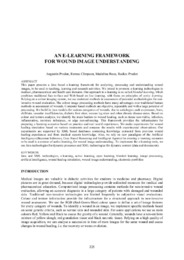| dc.contributor.author | Prodan, Augustin | en |
| dc.contributor.author | Câmpean, Remus | en |
| dc.contributor.author | Rusu, Madalina | en |
| dc.contributor.author | Prodan, Rodica | en |
| dc.coverage.spatial | CY - Λευκωσία | en |
| dc.creator | Prodan, Augustin | en |
| dc.creator | Câmpean, Remus | en |
| dc.creator | Rusu, Madalina | en |
| dc.creator | Prodan, Rodica | en |
| dc.date.accessioned | 2016-02-01T07:36:29Z | |
| dc.date.available | 2016-02-01T07:36:29Z | |
| dc.date.issued | 2007 | |
| dc.identifier.uri | http://hdl.handle.net/10797/14551 | en |
| dc.description | Περιέχει το πλήρες κείμενο | el |
| dc.description.abstract | This paper presents a Java based e-learning framework for analyzing, processing and understanding wound
images, to be used in teaching, learning and research activities. We intend to promote e-learning technologies in
medical, pharmaceutical and health care domains. Our approach to e-learning is so called blended learning, which
combines traditional face-to-face and Web-based on-line learning, with focus on principles of active learning.
Relying on a colour imaging system, we use statistical methods in assessment of potential methodologies for noninvasive
wound evaluation. The colour image processing methods have many advantages over traditional human
methods in assessment of wounds. Computer based methods are objective, repeatable and with a large potential of
processing. We build in Java models for various categories of wounds, due to aetiologies such as pressure, burn,
chilblain, vascular insufficiencies, diabetic foot ulcer, venous leg ulcer and other chronic disease states. Based on
colour and texture analysis, we identify the main barriers to wound healing, such as tissue non-viable, infection,
inflammation, moisture imbalance, or edge non-advancing. This framework provides the infrastructure for
preparing e-learning scenarios based on practice and real world experiences. We make experiments for wound
healing simulation based on various treatments and compare the results with experimental observations. Our
experiments are supported by XML based databases containing knowledge extracted from previous wound
healing experiences and from medical experts knowledge. Also, we rely on new paradigms of the Artificial
Intelligence (Bayesian Inference, Case Based Reasoning and Intelligent Agents) for creating e-learning scenarios
to be used in a context of active learning, for wound image understanding.. To implement the e-learning tools, we
use Java technologies for dynamic processes and XML technologies for dynamic content (data and documents). | en |
| dc.language.iso | eng | en |
| dc.publisher | University of Cyprus | en |
| dc.relation.ispartof | E- learning and distance learning | en |
| dc.rights | info:eu-repo/semantics/openAccess | en |
| dc.rights | Open Access | en |
| dc.source | CBLIS Conference Proceedings 2007 Contemporary Perspective on new technologies in science and education | en |
| dc.title | An e-learning framework For wound image understanding | en |
| dc.type | info:eu-repo/semantics/conferenceObject | en |
| dc.subject.uncontrolledterm | Java and XML technologies | en |
| dc.subject.uncontrolledterm | e-learning | en |
| dc.subject.uncontrolledterm | Active learning | en |
| dc.subject.uncontrolledterm | Open learning | en |
| dc.subject.uncontrolledterm | Blended learning | en |
| dc.subject.uncontrolledterm | Image processing | en |
| dc.subject.uncontrolledterm | Artificial intelligence | en |
| dc.subject.uncontrolledterm | Wound healing simulation | en |
| dc.subject.uncontrolledterm | Wound image understanding | en |
| dc.subject.uncontrolledterm | Electronic portfolios | en |
| dc.contributor.conferenceorganizer | Learning in Science Group, University of Cyprus | en |
| dc.contributor.coordinator | Constantinou, Constantinos P. | en |
